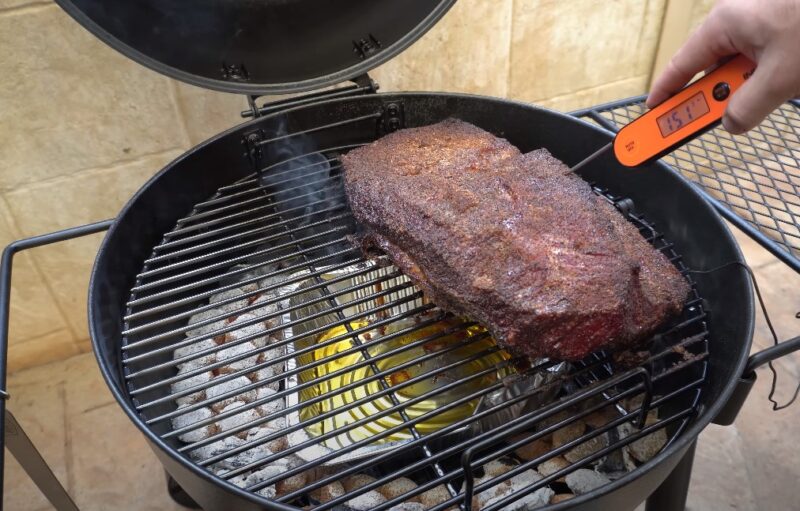Smoking the perfect brisket is not just about cooking; it’s an adventure in patience, precision, and passion. The key question we’re tackling is: how long does it take to smoke a brisket at 225 degrees Fahrenheit?
This in-depth guide will be your compass through the world of brisket smoking, illuminating the path from selecting the right cut to savoring that final, delectable bite.
General Guidelines
The common timeline of 1 to 1.5 hours per pound of brisket at 225 degrees Fahrenheit is a starting point, not a strict rule. Several variables can affect this, including the meat’s thickness, the fat content, and even the weather.
Use this guideline as a baseline, but trust your instincts and tools. A good meat thermometer is invaluable, helping you gauge when your brisket has reached its peak of perfection.
The Stall and Wrapping
The ‘stall’ is a rite of passage in brisket smoking. It’s a period where the meat’s internal temperature plateaus, often around 150 degrees Fahrenheit. This is caused by moisture evaporating from the meat’s surface.
To counteract this, many pitmasters employ the ‘Texas Crutch’, wrapping the brisket in butcher paper or foil. This helps to retain moisture and push through the stall, potentially saving hours off the cooking time. This method is especially important if you are looking for a faster way to cook brisket.
Why Temperature is Important?
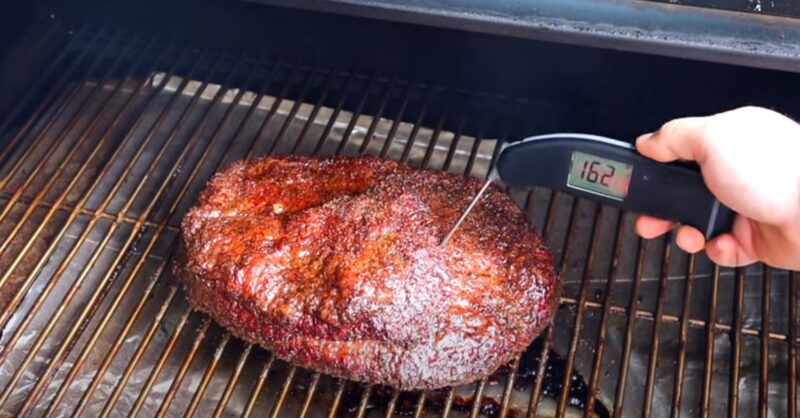
The internal temperature is the truest measure of a brisket’s readiness. Aim for an internal temperature of 195 to 205 degrees Fahrenheit. This range indicates that the connective tissues have melted into gelatinous goodness, creating a tender and juicy brisket.
Probe different parts of the brisket to ensure even cooking, and trust your thermometer over the clock.
The Poke Test
In addition to temperature, the tactile method of the ‘poke test’ can be revealing. Gently press a finger into the meat. If it yields softly, like a well-cushioned sofa, it’s likely done. If it’s resistant or bouncy, it needs more time.
This method requires practice, but it’s a valuable skill in any pitmaster’s repertoire.
Time Guide for Smoking Brisket at 225°F
| Aspect | Details | Duration |
|---|---|---|
| General Smoking Time | Standard guideline for smoking brisket at 225°F. | 1 to 1.5 hours per pound |
| The Stall | Period when internal temperature plateaus. | Varies; can last several hours |
| Wrapping (Texas Crutch) | Method to overcome the stall and retain moisture. | Typically begins when internal temp reaches ~150°F |
| Target Internal Temperature | Desired doneness temperature for the brisket. | 195-205°F |
| Resting Time | Resting period after smoking for juices to redistribute. | At least 1 hour |
The First Step is to Choose the Right Brisket
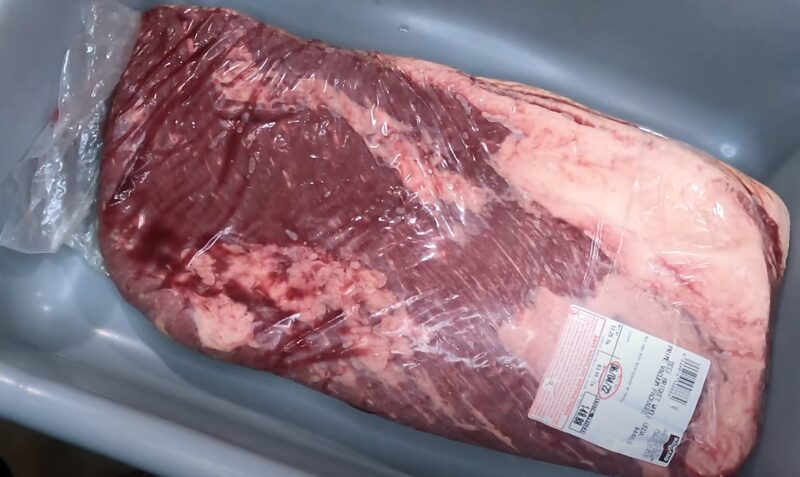
Brisket selection is a dance of discernment. You’re not just buying meat; you’re picking a canvas for your culinary art. Seek out a brisket with a marbled appearance; these white streaks of fat are the secret to moist, flavorful meat.
The ideal brisket has a thick, even fat cap on one side. This fat melts during cooking, basting the meat in its own juices. Remember, the brisket is made of two parts: the flat and the point. Each has its own character, and your choice will influence your smoking journey.
How to Prepare it?
Preparation is where your brisket begins its transformation. Trim the fat cap to about a quarter inch; too much fat can overpower the meat, too little, and you risk dryness. Your spice rub is your signature – it can be as simple as salt and pepper or as complex as a secret family recipe.
Coat the brisket evenly, massaging the spices into every crevice. This rub forms the ‘bark’, a crusty exterior that aficionados cherish. Your preparation sets the stage for the magic that happens in the smoker.
Set Up the Smoker
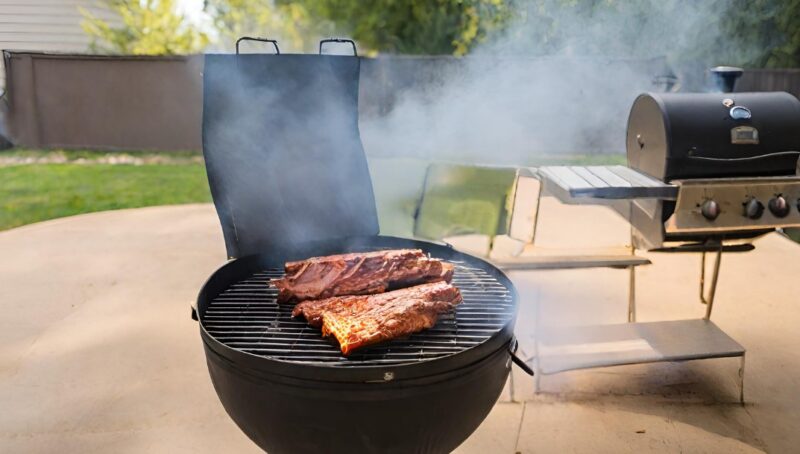
Your smoker is the altar where brisket magic happens. Clean it thoroughly; any residue from previous cooks can impart unwanted flavors. Achieving and maintaining a steady temperature of 225 degrees Fahrenheit is your goal.
This low and slow method is crucial for transforming tough brisket into buttery tenderness. Use a high-quality thermometer to keep a vigilant eye on the temperature, ensuring it stays consistent throughout the cooking process.
Control Smoke and Temperature
The smoke enveloping your brisket is as crucial as the heat. Different woods impart different flavors. Oak gives a subtle, smoky flavor, hickory adds a touch of sweetness, and mesquite offers a robust smokiness.
Balance is key – too much smoke can turn your brisket bitter. Temperature control is equally vital. Fluctuations can disrupt the cooking process, affecting both texture and taste. Be the guardian of your grill, maintaining a steady flame to achieve brisket perfection.
Resting and Slicing
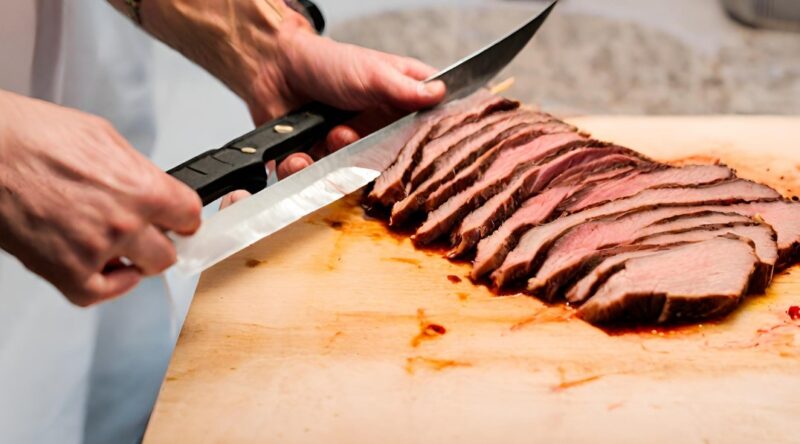
Resting your brisket is not just a suggestion; it’s an essential step. This pause allows the juices to redistribute, ensuring every slice is moist and flavorful. Wrap your smoked treasure in foil or a blanket and let it rest for at least an hour.
This patience will be rewarded with a brisket that’s succulent and tender, not dry and tough.
Slicing Techniques
The final act in your brisket odyssey is slicing. Use a sharp, long knife for clean cuts. Slice against the grain for maximum tenderness. The grain of the meat changes direction in different parts of the brisket, so adjust your slicing accordingly.
Thin slices are ideal for maximizing flavor and texture, turning each piece into a melt-in-your-mouth experience.
Serving and Pairing
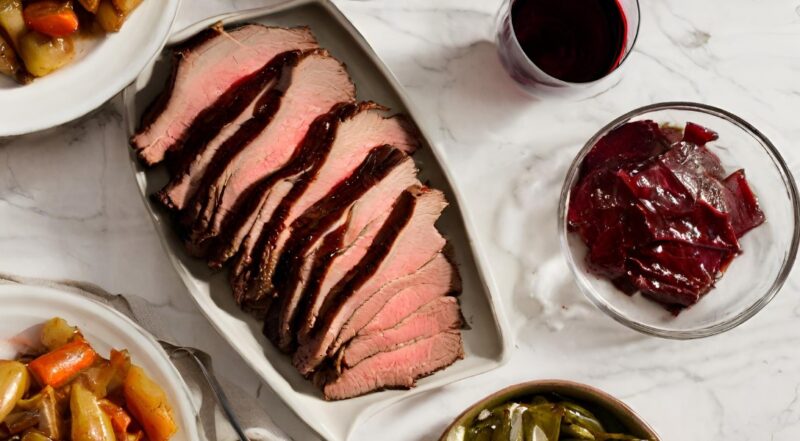
Brisket can be the star in a variety of dishes. Serve it as traditional slices, accompanied by classic sides like coleslaw and baked beans. Or get creative – brisket tacos, sliders, or even incorporated into a hearty chili. The rich, deep flavor of brisket makes it a versatile player in your culinary lineup.
Drink Pairings
What to drink with your brisket? Bold flavors call for bold pairings. A rich, smoky bourbon complements the meat’s depth. For wine lovers, a robust red like a Shiraz or Cabernet Sauvignon stands up well to the brisket’s intensity.
Beer aficionados might reach for a dark stout or a smoky porter, echoing the brisket’s own smoky notes.
Popular Drink Pairings and Serving Suggestions for Smoked Brisket
| Drink Type | Recommended Pairings | Serving Suggestions |
|---|---|---|
| Bourbon | Rich, smoky bourbons with notes of caramel and vanilla | Serve neat or on the rocks alongside sliced brisket |
| Red Wine | Robust reds like Shiraz, Cabernet Sauvignon, or Zinfandel | Pair with brisket served in a hearty stew or as part of a grilled platter |
| Beer | Dark stouts, smoky porters, or bold IPAs | Great with brisket sandwiches or burgers |
| Non-Alcoholic | Iced tea, lemonade, or smoky flavored sodas | Perfect for family-friendly events with brisket sliders or tacos |
Additional Tips for Perfect Dish
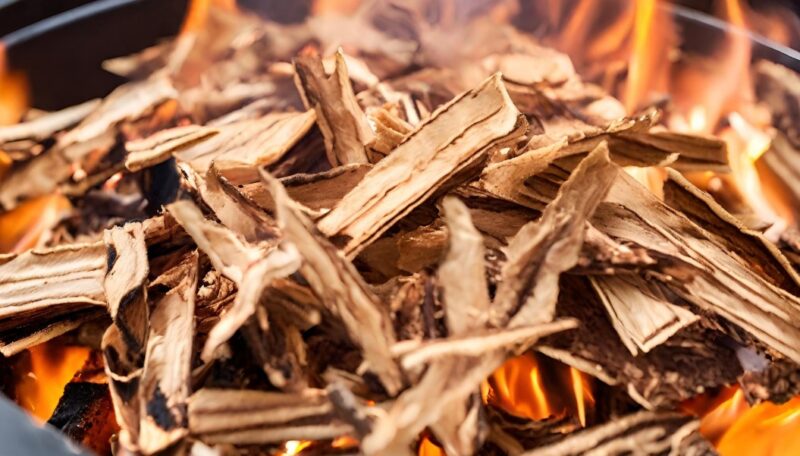
Smoking a brisket is both a science and an art, where minor details can significantly impact the end result. Here are some expert tips to elevate your brisket smoking game.
The Importance of Quality Meat
The journey to a perfect smoked brisket starts with selecting high-quality meat. Opt for a brisket that is well-marbled and has a good fat cap. The marbling (fat within the muscle) is crucial for flavor and tenderness, while the fat cap will melt during cooking, keeping the brisket moist.
A choice or prime grade brisket is often recommended for the best results.
Consistent Temperature Control
As we already mentioned, the best solution is to keep a steady 225 degrees Fahrenheit throughout the cooking process. Using a digital meat thermometer can help keep an accurate check on both the smoker’s temperature and the brisket’s internal temperature.
Proper Wood Selection
The type of wood you use for smoking can greatly influence the flavor of the brisket. Woods like oak, hickory, and mesquite are popular choices. Oak provides a mild, versatile smoke, while hickory adds a sweet, hearty flavor, and mesquite offers a strong, earthy taste.
The key is to find a balance – too much smoke can overpower the meat, and each type of wood imparts a different flavor profile.
Be Patient
Resting the brisket after smoking is as crucial as the cooking process itself. This resting period allows the juices to redistribute throughout the meat, resulting in a more tender and flavorful brisket.
Wrap the brisket in foil or a butcher paper and let it rest for at least one hour, though longer rest times can yield even better results.
Thin, Consistent Slices
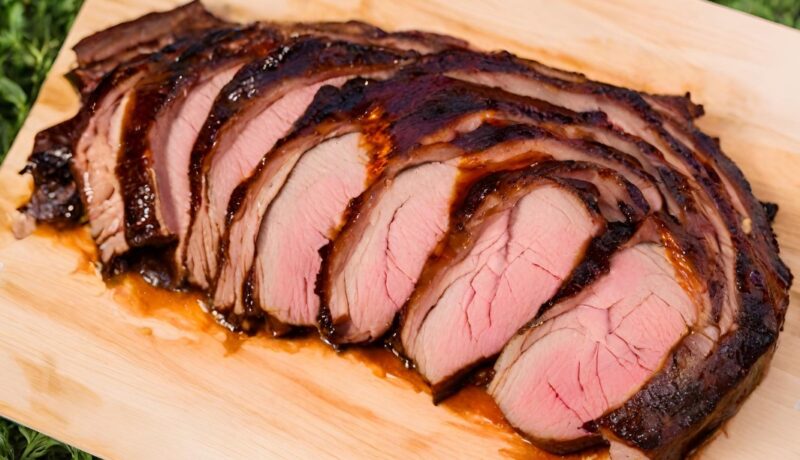
Slicing the brisket correctly can make a significant difference. Always slice against the grain, and try to keep the slices thin and consistent. This ensures that each bite is tender and easy to chew. Remember, the grain can change direction in different parts of the brisket, so adjust your slicing as needed.
| Tip | Detail |
|---|---|
| Quality Meat Selection | Choose a well-marbled brisket with a good fat cap for flavor and moisture. |
| Consistent Temperature | Maintain a steady temperature of 225°F for even cooking. |
| Wood Choice | Select the right wood for the desired smoke flavor. |
| Managing the Stall | Be patient during the temperature plateau and consider wrapping the brisket. |
| Resting the Brisket | Allow the brisket to rest post-cooking for juicier, more flavorful meat. |
| Slicing Technique | Slice against the grain for tender and easy-to-chew brisket. |
FAQs
How do I prevent my brisket from drying out when smoking at 225 degrees?
To prevent your brisket from drying out, ensure it has a sufficient fat cap when you begin. Keep the smoker’s lid closed as much as possible to maintain a consistent environment. Wrapping the brisket in butcher paper or foil once it reaches an internal temperature of 150-160 degrees Fahrenheit can also help retain moisture.
Is it better to smoke brisket fat side up or down at 225 degrees?
The choice of smoking brisket fat side up or down is often debated. Smoking fat side up allows the fat to baste the meat as it renders. However, smoking fat side down can protect the meat from direct heat if your heat source is below the meat. The best method can depend on your specific smoker and personal preference.
Should I inject my brisket before smoking at 225 degrees?
Injecting your brisket with a marinade or brine before smoking can enhance moisture and flavor, especially for leaner cuts. It’s not mandatory, but it can be beneficial if you’re aiming for extra juiciness and flavor infusion. Use a flavor injector and inject at various points throughout the brisket.
How often should I add wood chips when smoking brisket at 225 degrees?
The frequency of adding wood chips depends on your smoker type and the intensity of smoke flavor you desire. Generally, adding wood chips every 30-45 minutes during the first few hours of smoking is sufficient. After the brisket develops a crust, or ‘bark’, additional smoke does not significantly affect the flavor.
Can I use a water pan when smoking brisket at 225 degrees, and what are its benefits?
Yes, using a water pan in your smoker can be beneficial. It helps maintain a humid environment, which can aid in keeping the brisket moist and prevent the surface from drying out. The water pan also helps stabilize the temperature inside the smoker. Just be sure to refill it as needed during the smoking process.
Summary
Smoking brisket at 225 degrees Fahrenheit is a process that combines careful preparation, patient cooking, and attentive detail to achieve the perfect balance of flavor, tenderness, and moisture.
Key factors include choosing a well-marbled brisket, maintaining a consistent temperature in the smoker, selecting the right wood for flavor, and managing the ‘stall’ phase effectively.
Additionally, techniques like wrapping the brisket and allowing it to rest post-cooking are crucial for retaining moisture and enhancing flavor.
